The Eurasian Collared-dove and the Mourning Dove are two common species of doves found in North America.
While they share some similarities, such as their general appearance and coexistence in urban and suburban areas, there are distinct differences between these two dove species.
This article aims to highlight the characteristics, behavior, and habitats of the Eurasian Collared-dove and the Mourning Dove, allowing for a better understanding and appreciation of their unique attributes.
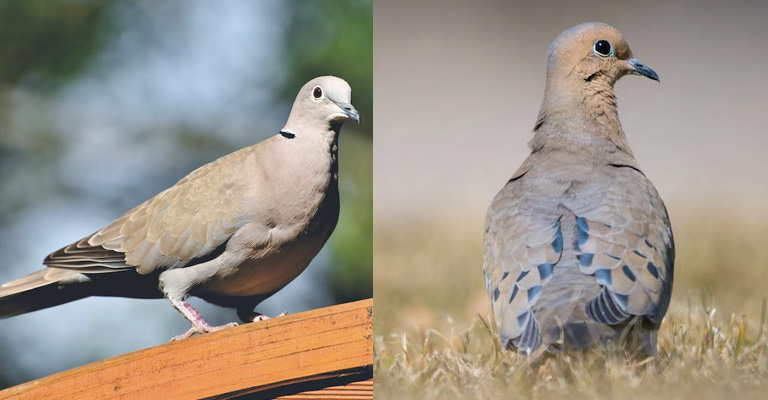
Appearance: Eurasian Collared-dove Vs Mourning Dove
The first thing you need to check is their appearance while identifying these similar-looking birds. Here are the facts of differences in their physical appearance.
Eurasian Collared-dove’s Appearance
The Eurasian Collared-Dove possesses a distinctive physical appearance. It has a plump body, giving it a rounded and substantial silhouette. Its head is relatively small in proportion to its body, creating a unique visual contrast.
Additionally, the Eurasian Collared-Dove boasts a long tail, which adds elegance to its overall profile. This combination of a plump body, small head, and long tail contributes to its distinct appearance.
Mourning Dove’s Appearance
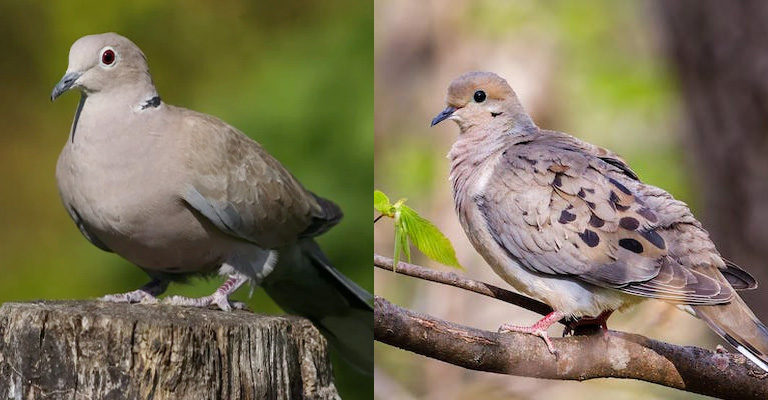
The Mourning Dove, another prevalent dove species, exhibits its own unique set of physical characteristics. Unlike the plump body of the Eurasian Collared-Dove, the Mourning Dove has a slimmer physique, giving it a sleek and streamlined appearance.
Furthermore, the tail of the Mourning Dove is distinctly pointed, which stands in contrast to the squared-off tail of the Eurasian Collared Dove. These variations in body shape and tail structure enable a visual distinction between these two dove species.
Comparison in Size and Tail Shape
When comparing the Eurasian Collared-Dove to other related species, such as the Mourning Dove and the Rock Pigeon, several differences become apparent.
The Eurasian Collared-Dove is larger than the Mourning Dove but more slender and longer-tailed than the Rock Pigeon. This distinction in size and tail shape allows for easy differentiation between these three species.
Understanding the appearance of the Eurasian Collared-Dove and the Mourning Dove allows us to appreciate the intricate details that make each species unique.
Their plump body, small head, and long tail distinguish the Eurasian Collared-Dove, while the slim body and pointed tail tip is characteristic of the Mourning Dove.
Coloration: Eurasian Collared-dove Vs Mourning Dove
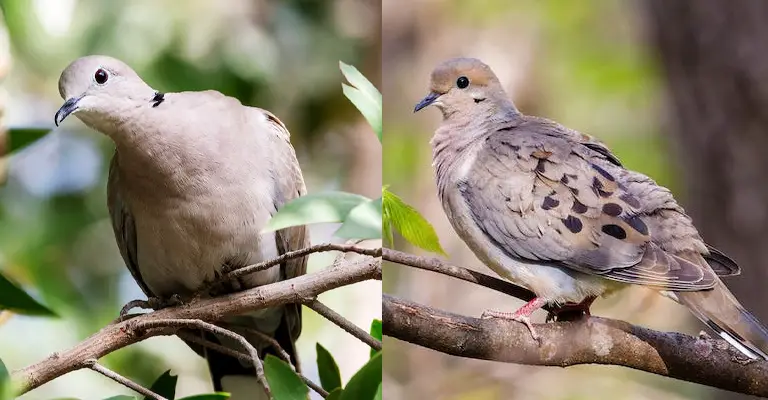
After the size and appearance, you can check the color of the feathers of these two birds. They are not the same at all. Here are some specific differences you’ll observe when identifying them.
Eurasian Collared-dove
The Eurasian Collared-Dove exhibits a striking coloration that sets it apart from other dove species. Its body is predominantly light grayish-brown, creating a soft and neutral base color.
Additionally, upon closer observation, a subtle pinkish hue can be detected, adding a touch of warmth to its feathers. This combination of light grayish-brown with a delicate pinkish undertone contributes to the distinct and visually appealing appearance of the Eurasian Collared-Dove.
Mourning Dove
In contrast to the Eurasian Collared-Dove, the Mourning Dove showcases a different color palette. Its feathers are characterized by a subdued gray-brown tone, creating a more understated and earthy look.
The coloration of the Mourning Dove’s feathers blends seamlessly with its surroundings, allowing for effective camouflage. This subdued gray-brown color serves as a defining feature of the Mourning Dove’s appearance.
Color Comparison: Eurasian Collared-dove Vs. Mourning Doves
One of the most distinguishing color features of the Eurasian Collared-Dove is the black collar that encircles the back of its neck. This bold black band contrasts with the light grayish-brown body, creating a visually striking pattern.
This distinctive collar is absent in Mourning Doves, setting the two species apart in terms of coloration. The absence of a black collar further emphasizes the subdued gray-brown coloration of the Mourning Dove’s plumage.
By examining the coloration of the Eurasian Collared-Dove and the Mourning Dove, we gain insight into the unique visual characteristics of each species.
The light grayish-brown body with a pinkish hue and the black collar of the Eurasian Collared Dove distinguish it from the subdued gray-brown feathers of the Mourning Dove.
Recognizing these color variations allows for accurate identification and a deeper appreciation of these fascinating dove species.
Vocalizations
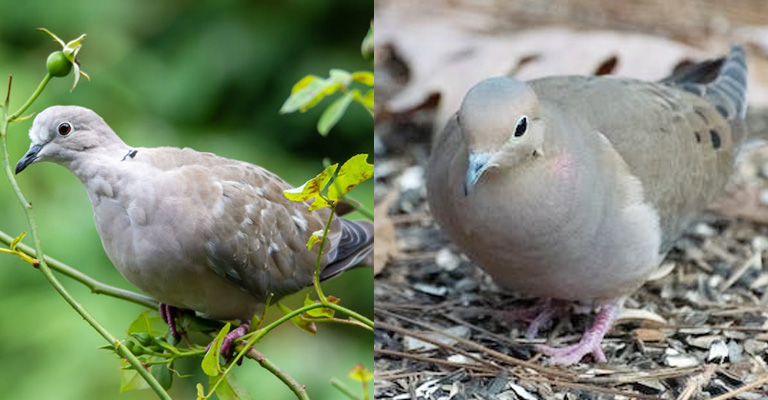
Eurasian Collared-dove and Mourning Dove have clear differences in their vocalization too. Here are the points that will help you understand the difference.
Vocalization of the Mourning Dove
The Mourning Dove is well-known for its distinct and mournful cooing sound. It produces a series of soft, melodic notes that sound like “coo-AH-oo.” This vocalization is often described as a gentle and melancholic call, resembling a mournful song.
The mournful cooing of the Mourning Dove is a common sound heard in various habitats and serves as a characteristic feature of this species.
Vocalization of the Eurasian Collared-dove
In contrast to the Mourning Dove, the Eurasian Collared Dove possesses a unique and easily recognizable vocalization. It emits a distinct three-note cooing sound, with the notes sounding like “coo-COO-coo.” This call is typically louder and more robust compared to the Mourning Dove’s cooing.
The distinct three-note pattern helps differentiate the Eurasian Collared-Dove’s vocalization from other dove species.
Comparison of Vocalization
When comparing the vocalizations of the Eurasian Collared-Dove and the Mourning Dove, several differences in volume and tone can be observed. The Mourning Dove’s cooing is generally softer and more subdued, creating a gentle and melancholic ambiance.
In contrast, the Eurasian collared doves cooing is louder and more assertive, capturing attention with its robust and resonant tones. These differences in volume and tone contribute to the unique character of each species’ vocalizations.
The mournful cooing of the Mourning Dove evokes a sense of tranquility, while the distinct three-note cooing of the Eurasian Collared-Dove commands attention.
By recognizing these vocal differences, we can further immerse ourselves in the fascinating world of bird communication and deepen our understanding of these remarkable dove species.
Habitat and Distribution
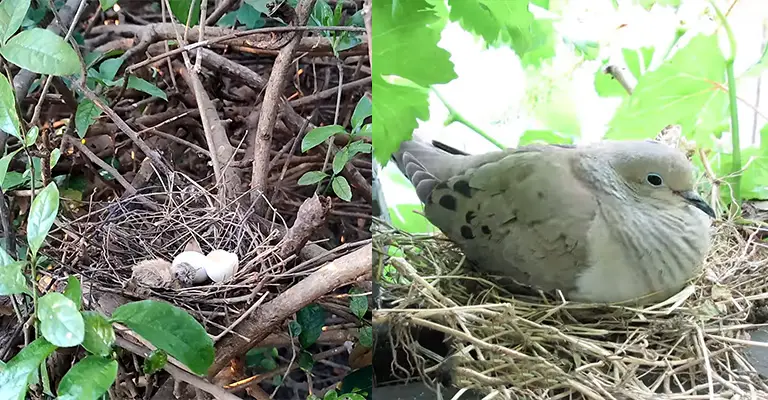
As usual, their habitats and distributed systems are not the same. Here are the concepts where they differ from each other.
Eurasian Collared-dove: Origin and Expansion
The Eurasian Collared-Dove has an interesting history of origin and expansion. It naturally originates from Southwest Asia and Southeast Europe. From these regions, the species began to expand its range rapidly, colonizing new territories across different continents.
It has successfully established populations in North America, among other regions. The expansion of the Eurasian Collared-Dove showcases its adaptability and ability to thrive in diverse environments.
Eurasian Collared-dove: Preference for Urban Areas and Agricultural Landscapes
The Eurasian Collared-Dove demonstrates a strong affinity for urban areas and agricultural landscapes. These doves are commonly found in cities, suburbs, and towns, where they take advantage of human-altered environments and readily available food sources.
Their adaptability to urban settings, along with their ability to utilize agricultural habitats, has contributed to their successful expansion and population growth in many regions.
Mourning Dove: Native Distribution
The Mourning Dove is native to North America and has a widespread distribution across the continent. It can be found in various habitats, including forests, grasslands, agricultural fields, and urban areas.
Mourning Doves are highly adaptable and can thrive in diverse environments, ranging from rural to suburban and even densely populated urban areas. Their adaptability and wide-ranging distribution make them a familiar and well-loved species throughout their native range.
Understanding the habitat preferences and distribution patterns of the Eurasian Collared-Dove and the Mourning Dove sheds light on their ability to occupy different environments.
The Eurasian Collared-Dove’s expansion from Southwest Asia and Southeast Europe to urban and agricultural areas demonstrates its adaptability and success as a colonizing species.
Conversely, the Mourning Dove’s native distribution in North America and its adaptability to various habitats highlight its versatility and wide-ranging presence.
Interactions and Behavior
Eurasian Collared-dove and Mourning Dove also have some dissimilarities in their interactions and behavior. You can identify them by these facts as well.
Coexistence With Other Species
Both the Eurasian Collared-Dove and the Mourning Dove are known to coexist with other bird species in their respective habitats. They can often be observed sharing feeding areas and perching on the same trees or utility wires.
This coexistence highlights the ability of these dove species to occupy niches alongside other avian species, fostering a diverse and interconnected ecosystem.
Positive and Negative Perceptions
Perceptions of dove presence vary among individuals. Some people perceive doves, including the Eurasian Collared-Dove and the Mourning Dove, as welcome and peaceful additions to their surroundings.
They appreciate their gentle demeanor and the soothing ambiance created by their cooing. However, others may view doves as a nuisance, particularly when they congregate in large numbers and compete for food or create messes.
These differing perceptions reflect the subjective experiences and preferences of individuals.
Enjoyment of Feeding in Various Settings
Feeding and observing doves, including the Eurasian Collared-Dove and the Mourning Dove, can be a source of enjoyment for many people. Providing food sources, such as bird feeders or scattered seeds, can attract these doves, offering opportunities for close observation.
Their calm demeanor and graceful movements during feeding and perching can be captivating, providing a sense of connection with nature and a peaceful respite in daily life.
Many individuals find joy and fulfillment in observing and appreciating the beauty of these doves in their natural habitat.
Understanding the interactions and behavior of the Eurasian Collared-Dove and the Mourning Dove helps us appreciate their role in the broader ecosystem.
Their coexistence with other species reflects the intricate web of interactions among different bird species. Additionally, recognizing the varying perceptions of dove presence highlights the diverse perspectives of human interactions with wildlife.
Finally, the enjoyment derived from observing and feeding doves emphasizes the positive experiences and connections individuals can develop with these remarkable birds.
Differences At A Glance: Eurasian Collared-dove Vs. Mourning Dove
| Eurasian Collared-Dove | Mourning Dove |
| Plump body | Slim body |
| Small head | Proportionate head |
| Long tail | Shorter tail |
| Squared-off tail tip | Pointed tail tip |
| Light grayish-brown body | Subdued gray-brown feathers |
| Pinkish hue | No pinkish hue |
| The black collar on the neck | No collar on the neck |
| Three-note cooing sound | Mournful cooing sound |
| Louder and robust vocalization | Softer and more subdued vocalization |
| Preference for urban areas | Adaptability to various habitats |
| Agricultural landscape inhabitant | Native to North America |
| Rapid expansion from SW Asia and SE EU | Widespread distribution in North America |
| Larger than Mourning Dove | Smaller than Eurasian Collared-Dove |
| More slender than Rock Pigeon | Similar size to Eurasian Collared-Dove |
| Broad, slightly rounded wings | Broad, rounded wings |
| Mingles with other dove species | Mingles with other dove species |
| Lighter color variation | Subdued color variation |
| Urban and agricultural Coexistence | Adaptable to various habitats |
| Distinct appearance and call | Recognizable appearance and call |
| Often seen in urban and suburban areas | Found in diverse habitats |
FAQs
While Eurasian Collared-Doves have expanded their range to various parts of the world, including North America, Mourning Doves are native to North America and are primarily found in this region.
Therefore, their natural ranges do overlap in certain areas.
Yes, Eurasian Collared-Doves and Mourning Doves have been known to hybridize where their ranges overlap. The resulting hybrids may exhibit intermediate characteristics between the two species.
Eurasian Collared-Doves are generally non-migratory and can be found year-round in their established territories. On the other hand, Mourning Doves are migratory birds, with populations in the northern parts of their range migrating south for the winter.
Both species typically build simple nests made of twigs, grass, and leaves. Mourning Doves tend to construct flimsier nests, while Eurasian Collared-Doves build sturdier structures using larger materials.
Conclusion
The Eurasian Collared-Dove and the Mourning Dove are distinct species with unique characteristics.
From their appearance and vocalizations to their habitat preferences and interactions, these doves captivate us with their beauty and adaptability.
So, if you want to differentiate them on your own, this guide must be a great help for you. Still, if you have any more confusion left, please inform us in the comment section. Thank you for your time.